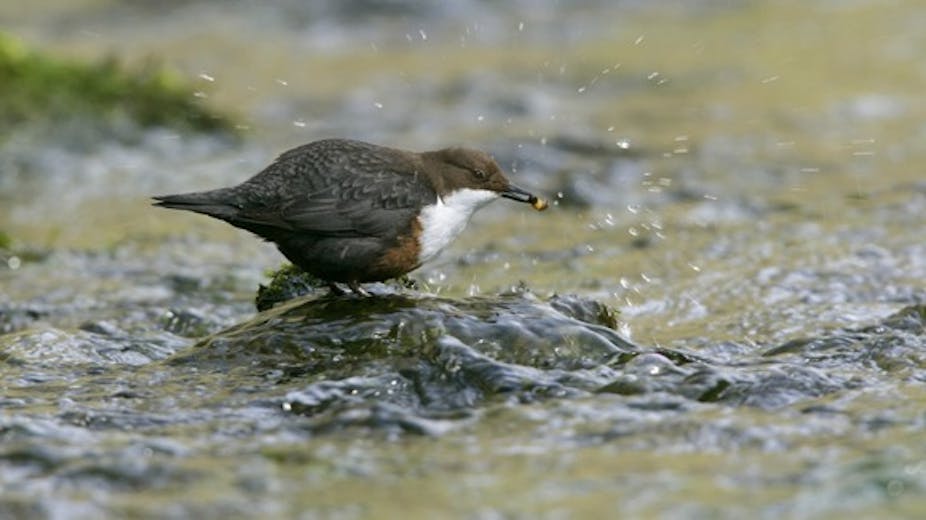Hormone-disrupting pollutants in the urban rivers of South Wales are having adverse effects on the health and development of wild birds such as dippers.
Research we’ve undertaken in collaboration with the Universities of Saskatchewan and Exeter, alongside staff from the Natural Environment Research Council, shows that the chicks of dippers feeding along urban rivers have depressed thyroid hormone activity – in the case of one thyroid hormone by almost 50%. Urban dippers hatch fewer female chicks than those nesting in rural rivers nearby, while urban chicks are also underweight by comparison with their rural counterparts.
Dippers are thrush-sized river birds that feed exclusively on fish and insects, and they acquire pollutants through this river-sourced diet. Our earlier evidence had shown already that urban dippers lay eggs with significantly increased levels of pollutants – particularly PCBs (polychlorinated biphenyls) and PBDE (polybrominated diphenyl ethers), which have been used as flame-retardant chemicals in textiles, building materials, plastics and vehicles. Indeed, the concentrations of PBDEs in the eggs of Wales’ urban dippers are among the highest ever detected in songbirds anywhere in the world. These elevated concentrations are enough to explain adverse effects on chick development.
All in all, these are worrying signs that could have negative implications for the breeding and survival of dippers and potentially other wild birds and animals that use urban rivers as habitat.
Better than canaries?
The use of plants and animals like dippers as indicators of environmental safety or quality is a long-standing idea. The most celebrated example is the canary – which in mining regions such as South Wales were once carried far underground to warn colliers of the presence of suffocating gases: if the bird stopped singing and fell from its perch, it was a bad sign for the men and children who also worked in the mines.
Might it be possible that dippers are a modern-day example that is at least as good?
Over the last 30 years, I’ve investigated how a range of environment changes has affected dippers and their biology. In the 1980s, it was possible to show how problems such as acid rain reduced the numbers of insects that dippers used as prey, leading to equally marked reductions in dipper numbers.

Where there was a scarcity of calcium-rich prey (critical for egg-shell formation and found in fish, freshwater shrimps and snails), dippers laid lighter eggs with thinner shells. And, in rivers polluted by insecticide residues or PCBs from local agriculture or industry, concentrations of these chemicals accumulated in dipper eggs to reveal the most affected regions and river systems. In one case, contaminants in eggs even pinpointed a single pollution source from a scrapyard that had been missed by the local regulatory authority.
The concept of dippers as river indicators has been picked up in other nations too. In Canada and North America, researchers such as my collaborator Christy Morrissey used eggs of the American dipper to reveal patterns in the pollution climate across whole continents. Canadian rivers, for example, were generally cleaner and lower in persistent pollutants than those in Europe.
Morrissey and I also used dippers to reveal where migrating Pacific salmon “bio-transported” pollutants from the continental shelf into Pacific river systems. In Nepal and India, we’ve used another dipper species, the brown dipper, to investigate how agricultural intensification affected Himalayan river ecosystems through pollution, altered river habitats and reduced food abundance.
Twist in the tail
Now, this story of dippers and their powerful value as indicator species has once more come home to Wales – and to very same mining areas where canaries were once taken underground.
Only 30 years ago, the rivers of the South Wales coal field were grossly polluted by sewage and colliery discharges, and dippers were nowhere to be seen. As these and other urban rivers have been progressively cleaned-up, dippers have once again started to breed in numbers along these formerly polluted rivers. But our new findings show how this story has a twist in the tail.
Although they’re breeding again along South Wales’ urban rivers, dippers once again appear to be telling us something. Despite cleaning up gross pollution, subtle toxic effects might well persist in the urban environment, as shown by the persistent pollutants present in dipper eggs and in the apparent effects on their chicks.
As with the canaries of old, this is a warning that we should heed.

